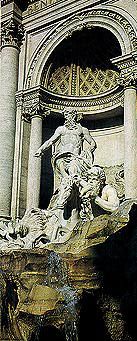 |
 |
 |
 |

Rome, which was the center of the papacy, was a prosperous administrative center and also served as a tourist center for thousands of pilgrims. During the seventeenth century its population began to grow quickly, to about 135,000 people. As the center of the Papal States, Rome expressed the struggle of the Catholic establishment for complete control of Christians worldwide.
In the fifteenth and sixteenth centuries, the Renaissance and humanism reached their peak in Italy. This can be seen in the rediscovery of the classical culture of Greece and Rome, expressed principally in man's ambitions, thoughts and desires. Italian scholars investigated these ideas and the invention of printing helped to spread them. Art came more and more to express the will of man, and the Catholic Church and its leaders were influenced by the Renaissance and humanist trends. St. Peter's Church was designed by Michelangelo in this spirit, which also gave rise to the paintings and inventions of Leonardo da Vinci.

Papal government
During the sixteenth century, the attitude of the Catholic Church underwent a change. A new religious movement, led by Martin Luther, was spreading through Europe. Several European rulers, in Germany, England, Scandinavia, and the Netherlands, adopted the new approach ( Protestant Christianity. The leaders of the Catholic Church felt that the new movement threatened the Church's special status, and took up arms against it. They tried to halt the movement by strengthening the power and authority of the pope.
A Council of the Church was called at Trent in 1545. The Council met several times over the next 18 years, and started a process of church reform that led to the strengthening of the church and the power of the popes. The popes worked to prevent any discovery or innovation that could undermine the position of the Catholic Church.
Excommunication and bans were used as weapons in this struggle. Pope Paul III (1534-1549) reinstated the Inquisition, and Paul IV (1555-1559) introduced censorship in the form of the Index of forbidden books. The Index included books written by Protestants, humanists, and scientists. The religious struggle was not restricted to religious leaders, but spread to secular leaders, some of whom regarded themselves as bound to the Pope, while others wanted greater independence. From 1618 onwards, the Catholic and Protestant kings of Europe fought each other for 30 years. Like the Council of Trent, this struggle helped the Catholic Church to harden its attitudes and fight against every new discovery that could be interpreted as defying the Church's authority.
Economics
The long war also had an influence on the economic life of the Papal states. Resources were diverted from economic development to building defensive walls and paying military advisors. The religious wars of the European kings were also paid for by the Papal states, which caused a deficit in the papal treasury.
 The Church as a patron of culture
The Church as a patron of culture
At the beginning of the seventeenth century, Paul V was elected as Pope. Even though he was famous for his piety and religious devotion, he invested large sums of money in supporting the arts, impelled also by political factors. The Church wanted to demonstrate its power and influence, and to be regarded as an encouraging rather than as an oppressive power. Paul V was responsible for building the many fountains of Rome. He claimed that he was restoring Rome to its appearance in the emperor Trajan's time, when the city had possessed 1,300 fountains. He also restored palaces and churches, and employed the sculptor and architect Bernini, who carved a particularly famous statue of David.

When Maffeo Barberini was elected as Pope Urban VIII in 1623, he made Bernini the chief sculptor and architect of the Vatican. As part of his duties, Bernini designed parts of St. Peter's Church as well as St. Peter's Square and its colonnades.

 Italy
Italy
 The Venetian Republic
The Venetian Republic
 The Duchy of Tuscany
The Duchy of Tuscany

| Andrea / | Mail / | Home Page |
|---|
 |
 |
 |
|---|
![]() KNOWMAGINE - http://muse.tau.ac.il/~museum
KNOWMAGINE - http://muse.tau.ac.il/~museum